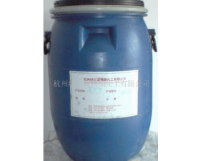- 纺织阻燃剂可以通过什么原理起到阻燃的效果?
- 本站编辑:杭州纳尔森精细化工有限公司发布日期:2018-06-22 21:37 浏览次数:
纺织品本身易于燃烧和易助火焰蔓延,一般可燃物要有三个要素:事实上的温度、产生可燃性气体以及氧气,缺少任何一个要素,燃烧就无法进行下去。
The textile itself is easy to burn and facilitate the spread of the flame, and the general combustible must have three elements: the actual temperature, the combustible gas and the oxygen, and the lack of any one element, and the combustion can not go on.

纺织阻燃剂可以通过改变纤维的热裂解控制燃烧起到阻燃的作用。
Textile flame retardants can control the combustion by changing the thermal decomposition of the fibers to play the role of flame retardancy.
纤维素纤维在受热(燃烧)后的裂解反应有两个方向:一是纤维素脱水炭化,生成水,二氧化碳和固体残渣(这不是继续燃烧的原因);二是纤维素通过解聚生成不挥发的液体左旋葡萄糖,左旋葡萄糖进一步裂解,生成低分子量的裂解产物,并形成二次焦炭。这些低分子的裂解产物中不乏低沸点的醇类、醚类、酮类、醛类等物质,在氧的存在下,发生氧化,同时产生大量热,又引起更多纤维素的裂解。而且这些气化的低分子物质燃烧更加速了火焰的蔓延。这两个反应相互竞争,始终存在于纤维素裂解的整个过程。阻燃整理后,含磷的阻燃剂在燃烧的过程中产生磷酸酐或磷酸,对纤维素的脱水、炭化有催化作用,阻止了左旋葡萄糖的生成,从而减少了可燃性裂解产物的生成,促使了水、二氧化碳和固体残渣量的增多;且即使有部分可燃烧的裂解产物产生,在阻燃剂分解出来的磷酸作用下,也会变成具有较大炭化倾向的物质。由于可燃性裂解产物的减少和阻燃剂本身吸收部分热量,使阻燃织物的释放热量大大降低,延缓了纤维的继续裂解。因此当火源离去时,能自动熄灭。
There are two directions for the cracking reaction of cellulose fibers after heating (combustion): one is dehydrated carbonization of cellulose, producing water, carbon dioxide and solid residue (this is not the cause of continuous combustion); the two is that cellulose is depolymerization to produce nonvolatile liquid left glucose, and left glucose is further cracked to produce low molecular weight. The amount of the pyrolysis products and the formation of two cokes. There are no lack of alcohols, ethers, ketones and aldehydes in these low-molecular-weight cracking products. In the presence of oxygen, oxidation occurs in the presence of oxygen, producing a large amount of heat and causing more cellulosic cracking. Moreover, the gasification of low molecular substances accelerated the spread of flame. These two reactions compete with each other and always exist in the whole process of cellulose pyrolysis. After flame-retardant finishing, phosphorus containing flame retardant produces phosphoric anhydride or phosphoric acid during the combustion process, which can catalyze the dehydration and carbonization of cellulose, prevent the formation of left-handed glucose, thus reduce the production of flammable cracking products and increase the amount of water, carbon dioxide and solid residue, even if some of them are flammable. The pyrolysis products, which are produced by the phosphoric acid decomposed by flame retardants, will also become substances with larger carbonization tendency. Due to the reduction of flammable cracking products and the absorption of some heat from the flame retardant, the heat release of the flame retardant fabric is greatly reduced, and the continuous cracking of the fiber is delayed. So when the fire is gone, it can be extinguished automatically.
- 上一篇:纸张木材阻燃剂怎么使用?
- 下一篇:阻燃剂具有哪些要求及要素?






